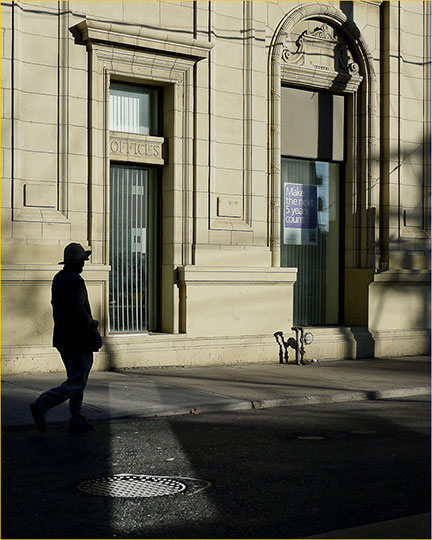
One of the longstanding commercial battles in the consumer electronics business has been that between Sony and Panasonic. There is hardly a segment of the market where these two Goliaths don’t go toe-to-toe. This now includes the digital camera marketplace.
Both companies have been much more innovative than those industry stalwarts, Canon and Nikon. Responding to consumer’s demand for smaller, lighter cameras and lenses Sony has put forward their NEX system, while Panasonic is the leading proponent of the Micro Four Thirds format.
Panasonic has been on a bit of a tear these past couple of years with seven M43 format cameras, the G1, GH1, GF1, G10, G2, GH2 and now in Nov, 2010 announcing the GF2. The also new GH2 is Panasonic’s current flagship, and is previewed in my recent GH2 Report. With the GH2 as the obvious successor to the GH1, with a higher resolution sensor and enhanced video capability as well as a number of other tweaks and enhancements, one would therefore think that, similarly, the GF2 would be the successor to the GF1. Not so.
Make it Count. Toronto, November 2010
Panasonic GF2 with 14mm @ ISO 100
What it Isn’t
Whatever the GF2 may be (and I’ll tell you in a moment what ecological niche I think it is intended to occupy) it is not a linear successor to the GF1. The GF1 was intended as the smallest possible M43 camera without a built-in electronic viewfinder. It was clearly aimed at the enthusiast photographer who wanted a pocketable interchangeable lens camera that did not relinquish manual controls for the sake of small size. In this it was very successful, and with its intelligently designed user interface engendered a very loyal and enthusiastic following.
But, then along came Sony with the NEX 3 and NEX 5, which I previewed here, andreviewed here. Though it has an APS-C sized sensor, which is larger than Four Thirds, the body was in fact noticeably smaller than the GF1. (Lenses are another matter, and we’ll look at this topic shortly).
This once again threw a spanner into the Micro Four Third camp’s works. When the original Four Thirds format was introduced I wrote that it appeared to be an “evolutionary dead end”. That was my impression at the time, because the trade-off of a smaller sensor vs. reduced camera weight and bulk was not successfully achieved. The need for a reflex mirror and prism just didn’t allow for a great enough size and weight reduction, and clever engineering by other camera makers rapidly rendered Four Thirds’ anticipated advantages moot. (As it turns out, I was right, and the standard Four Thirds format, though still supported by Olympus, seems to have become marginalized).
Salvation for the Four Thirds consortium came in 2008 in the form of the Micro Four Thirds format. By eliminating the reflex prism and mirror box significant camera body size and weight savings could be achieved while keeping the sensor size the same. And, with a much shorter back focus distance smaller and lighter lenses were also possible.
But, as the saying goes –two can play at that game. Sony’s NEX mount cameras play the mirrorless card, but do so with a larger (APS-C) sized sensor. Panasonic clearly had to counter, and the GF2 is their response to Sony’s challenge.
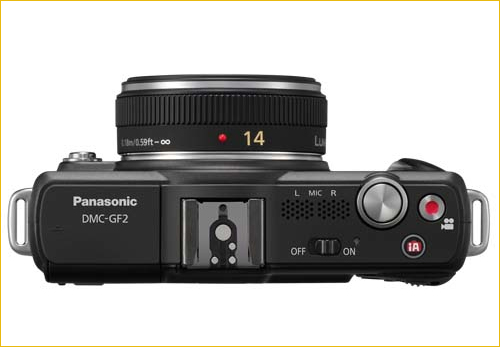
Angst On The Forums
When the GF2 was announced the members of one of the popular camera review site’s forums reacted with vocal disappointment. The GF2 simply wasn’t a better GF1, as its name would imply, and as some had hoped. Instead it was much like a (horror of horrors) a NEX – no top shooting mode dial, no shutter mode lever, no AE/AF lock button, no AF/MF button, and overall a reduced physical user interface, with a touch screen replacing many of the previous haptic controls.
Current GF1 owners were therefore understandably disappointed. As we’ll see, the problem wasn’t that the new GF2 was a poor camera – anything but. It’s just that given its model number the camera didn’t jibe with user’s expectations. It isn’t an updated GF1. Rather it’s something new – Panasonic’s rejoinder to the Sony NEX.
What It Is
If you accept that the GF2 is Panasonic’s first (though likely not its last) response to Sony’s NEX, it makes sense. In many ways it beats Sony at its own game.
The GF2 is small. The smallest M43 camera yet. But, it still isn’t as small as the NEX 3 and 5, which it competes against most directly. But, its close enough so that in a retail comparison, even if one is driven to want the smallest and lightest interchangeable lens camera available, there is little to choose between them when it comes to the space that they take up in one’s jacket pocket.
- The basic specs of the GF2 are as follows…
-
12.1 Megapixel CMOS sensor
- sensitivity from ISO 100 – 6400
- touch screen interface
- 1920 x 1080/60i video (Full HD) in AVCHD at 17 Mbps (shot at 30P using segmented frame)
- hot shoe
- built-in flash
-
While some will think it strange that I mention the hot shoe and the built in flash, since these are now de-riguer on almost any camera in any category, they don’t exist on the NEX, and therefore these are competitive selling points for Panasonic. Not everyone needs a built-in flash, but in this market segment it is definitely desirable. Sony provides a small plug-in flash, but it’s less convenient than one that simply pops up.
The hot shoe on the GF1 also allows any larger Panasonic flash to be used, and of course other types of shoe mount accessory – none of which is possible with the NEX bodies because of their lack of a shoe, and the fact that the one attachment point is a proprietary socket. Using any sort of viewing or shooing accessory with the NEX therefore becomes highly problematic. Form over function, I’m afraid.
The EVF Factor
When I previewed the NEX 5 I noted the proprietary accessory socket and suggested that like Panasonic does, Sony would soon provide an accessory electronic viewfinder. Sadly, in the six months since the NEX’s introduction there has been no hint of an EVF, nor a suggestion that one was even possible on the available connector.
My personal bias is that an eye level viewfinder of some sort is a must. Lots of people may disagree. That’s fine. But I find a camera without an optical finder, a reflex viewfinder, or an electronic viewfinder, seriously hinders my ability to shoot effectively and pleasurably in a variety of situations.
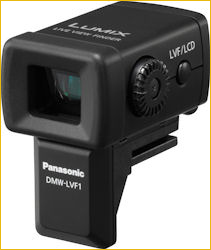
The GF2 has a socket for Panasonic’s accessory LVF-1 electronic viewfinder. Frankly this is nowhere near as good as the one built into the GH1 or GH2, but in my book it’s better than having to hold the camera at arm’s length in bright sunlight or other situations where the rear LCD is inconvenient or inappropriate.
In Use
Which brings us to the question of how does the GF2 handle and how does it compare to the GF1? Frankly, for myself (and yes, I own a GF1) the GF2 is a disappointment. I like cameras with manual controls. I’m not just bothered by, but I actively dislike cameras without tactile controls, regardless of their size. Small is good, but not when it interferes with basic operability.
The combination of what external controls there are and the GF2’s touch screen gets the job done. Indeed the touch screen is rather cool, allowing touch focus, touch shooting, and even niceties such as being able to touch the on-screen histogram and drag it to where you want it located. On playback you can swipe left and right with your finger to change images, just as with an iPhone. And Panasonic has even included the ability to customise their Quick Menu system with the icons that you want, organized in the order that you want them.
This all adds up to a very appealing interface that runs rings around the atrociously designed controls and screen menu of the Sony NEX cameras. I’ve already ragged on Sony’s truly awful NEX user interface (along with every other reviewer), so I won’t say more here, other than that Sony needs to get their “A” team on the job ASAP. Panasonic has shown that a small camera can have a usable interface, even when it might not appeal to photographers like me that prefer traditional tactile controls.
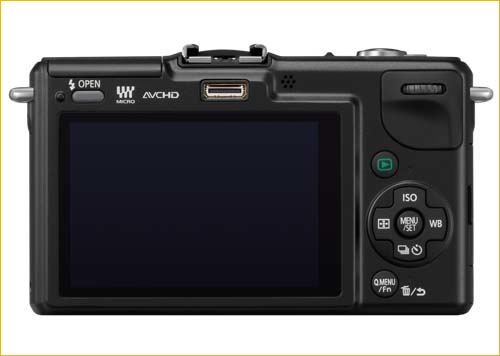
No Mode Dial
The most obvious change externally between the GF1 and GF2 is the lack of a mode dial, being replaced by a virtual one on the LCD touch screen. Curiously, I found that in Program mode the camera seemed to insist on shooting with the lens wide open. Whether this is typical, or just a glich in my pre-production sample I can’t be sure.
Note that the virtual mode dial as well as most other screen-based controls can be addressed either through touch, or via the rear panel’s four-way controller.
I should add, parenthetically, that one of the things that I dislike about cameras without a physical mode dial is that one can’t at a glance tell what mode the camera is in. It requires making sure that it’s turned on, and then accessing the appropriate menu screen. This just gets in the way of taking images. Maybe OK for shooting Sally’s birthday party, or the 483rd shot of the cat sitting on the couch, but…..
iA
The GF2 has an cute illuminatediAbutton on the top that puts the camera into an intelligent automatic mode where everything is taken care of – just point and shoot. This, in my opinion, is the way to satisfy the beginner who is looking to step up from a simple point and shoot. A single button that removes all decision making and which provides pretty good results without effort. Then, when that person decides they’d like to learn more about photography and how to use the tools available, a menu and control system that provides a broad range of functionality. Nicely done Panasonic.
Video
I didn’t do much in the way of video shooting, but certainly the update to Full HD will be appreciated. 17 Mbps is not the top rate that AVCHD is capable of, but enough to produce quite decent home quality videos.
The Kit Lens
Likely to keep size as small as possible the kit lens provided is either a 14mm f/2.5 pancake lens, or a 14-42mm zoom. The one I tested had the 14mm. This is a curious choice over the 20mm f/1.7 that came with the GF1, because though smaller, it is a stop slower and a lot wider. At the equivalent of 28mm this is somewhat wider than most people prefer on what might be their one and only lens. But, it does help keep the camera petite.
Battery
The GF2 has a new battery, one that’s smaller and with less capacity than the one in the GF1. I guess shrinking the camera meant also shrinking the battery.
Image Quality
I only had the GF2 for testing for a few days – not enough to do any serious pixel peeping. I also did all of my shooting in JPG mode, since currently the only raw software is the provided Silkypix, which I don’t care to use. I’m sure that Adobe will support the GF2 in their next update to Camera Raw and Lightroom, possibly by the time the camera ships early in the new year.
But what I see on screen and in prints up to Super A3 (13X19″) is similar image quality to that from the GF1, which is to say, pretty good indeed. The 12MP sensor in the GF2 is said to be the same as that in the GF1, but apparently the support electronics have been improved, and high ISO shots do seem to be a bit cleaner than on the GF1. I’m sure that the usual camera review sites will have their full tech reviews and sample pics to download in the near future, for those that obsess over such things.

Forlorn. Toronto, November, 2010
Panasonic GF2 with 14mm @ ISO 100
In Summary
The GF2 will be available in a range of colours, including black, of course. The pre-production sample which I had for testing was red . My first response when it was handed to me was to kid the Panasonic rep about the colour, but then he pointed out that my iPhone case was almost the same colour, and I shut up.
Interestingly though, during the few days that I shot with the GF2 a number of people (including a couple of “serious” photographers) came up to me asking to see the camera, and everyone said that it looked pretty cool. So when it comes to cameras with finishes other than black or chrome, don’t look to me for advise. Whatever you do though – don’t buy the pink model unless you plan on putting a Miss Kittysticker on it!
As for the question of whether to buy one, I think that there are two answers. If you already own a GF1 I would suggest that there really isn’t a compelling reason to upgrade, because it really isn’t an upgrade; it’s a sidegrade if anything. Panasonic just wasn’t targeting the GF2 at you.
If you don’t already own a GF1, and are looking for the smallest possible large sensor interchangeable lens camera, the choice will likely come down to the GF2 or the NEX 3 / 5. (Olympus and Samsung also have offerings in this segment, but I’m currently not familiar with them). Between these I would choose the GF2 because of its superior user interface and availability of a EVF, hot shoe, and built in flash. The Sony NEX though offers somewhat higher resolution and a larger sensor. You really should check out both for yourself.
November, 2010
You May Also Enjoy...
Impressions of Light
[caption id="" align="aligncenter" width="432"] Table Mountain, California 2006 Canon EOS-1Ds Mark II • 70.0-200.0 mm • 1.6 sec at f / 22 • ISO 100[/caption]
Eroding Rights
Article and Photographs by: Nick Rains Apostles - a permit for nature photography in Victoria costs either AUD275 for a year or AUD88 per day.This
